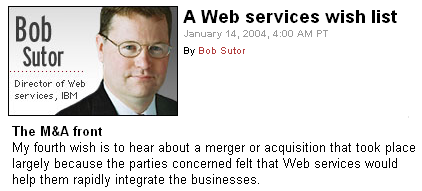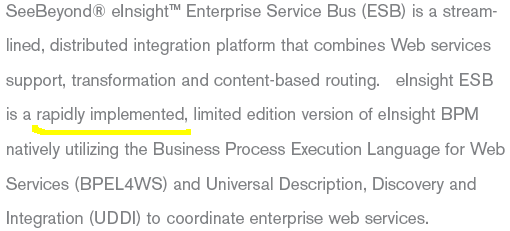| Service Oriented Enterprise |
|
Friday, January 23, 2004 Does the Service Fabric make the SOA Obsolete? I had an interesting question posed to me recently: Does the service fabric make the SOA pattern obsolete? First, be clear. I have a very clear definition for the SOA: 1. It is an architectural pattern 2. It uses 3 actors (directory, consumer and producer) 3. Whereby, the consumer looks up an interface to a producer in the directory 4. The consumer creates a binding to the producer and calls it The SOA pattern allows for dynamic lookup and binding, which means that it is a vehicle for finding the *right* implementation of a service at runtime. The service fabric often plays a similar role, but it often does it using routers. In this case, the fabric is aware of the implementations of a given service and when a message is sent to it, it can dynamically send the message to the *right* implementation. So, both techniques allow for a message to be dynamically delivered to a destination. But, does one make the other obsolete? In my opinion, the answer is, "no". I am of the opinion that people will often mix the techniques. In essence, the service call will still be designed to do a UDDI style lookup, but the destination may likely point at a router. Alternatively, developers will continue to write services and populate the descriptions in a directory, then make their router aware of the directory. In this case, the directory is still being used, just by the router instead of the programmer. posted by jeff | 6:50 AM Wednesday, January 21, 2004 Let's Merge! Did anyone else catch this?  What? I say what? Can you imagine the CEO of J.P. Morgan Chase and the CEO of Bank One Corp. talking before their merger about web services? "WHAT??? Bank One isn't using web services - THE DEAL IS OFF!!!" posted by jeff | 8:45 PM Sunday, January 18, 2004 SeeBeyond does rush job? I found this in the new literature for the SeeBeyond ESB/BPEL implementation:  For some reason, the phrase "a rapidly implemented, limited edition version" doesn't make me feel all warm about the product.... Here is how I read through the lines: 1. Product Marketing didn't give Engineering time to do it right 2. Engineering is likely pissed, and let marketing know it 3. Marketing is OK with it, because they still can't figure out how to position the ESB against their more profitable lines 4. A 'limited edition version' will give marketing more time to think about what to do about the 'creative disruption' of SOI posted by jeff | 5:41 PM |
|
|||||||||||||||
|
|
||||||||||||||||